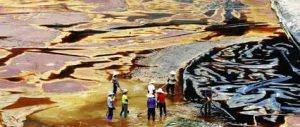The Qiantang River is the most important river in China’s eastern Zhejiang province, one of the country’s most developed regions. On its banks, textiles plants work to supply fashion labels around the world. But they are polluting the environment in the process. A Greenpeace report published in October revealed that two industrial zones in the cities of Hangzhou and Shaoxing have long been dumping toxic waste into the Qiantang.
As in so much of China, economic growth here has won out over effective environmental management.
Shaoxing is “built on cloth”. The textiles industry accounts for more than 58% of local industrial output. In 2010, over 17 billion metres of cloth were dyed or printed here.
There used to be a lot of small dyeing plants in Shaoxing, many of them family businesses. But since Binhao Industrial Zone opened in June 2002, many have closed down, merged, or shifted to Binhao, which offers preferential rents and financial support to tenants.
Similarly, Xiaoshan’s 160-square kilometre Linjiang Industrial Zone, which opened in March 2003, is now home to factories focused on textile and dyeing, machinery and car parts, and new building materials.
Visiting Linjiang in December, I was shocked to see chimneys at a large chemical plant pumping fumes out 24 hours a day, leaving an acidic odour in the air. Next door, several hundred mu of vegetable crops were being harvested, packed and sent to city markets.
Some of the villagers’ homes sit no more than 50 metres from the dyeing factories. Rivers and streams here have turned black and fetid, ruining local quality of life.
The county of Shaoxing (part of Shaoxing city) is under huge pressure to save power and cut pollution. In 2009, around 186 million tonnes of waste-water was released in the county – almost 510,000 tonnes a day, accounting for 60% of the city’s total discharge. All of the factories in Haibin Industrial Zone are given pollution quotas, and the county is experimenting with emission trading.
Illegal dumping of waste-water
Everyone in the industry knows that dyeing cloth is a water-intensive process. Almost every part of the process requires water.
Lao Chen, from Henan, is an employee at Zhejiang Huadong Textile and Dyeing. The firm moved into Haibin Industrial Zone in 2008. He said that at high temperatures cotton can absorb 85% of the dye – the remaining 15% is released as polluted waste-water. At low temperatures, 30% of the dye is lost.
The desizing process, in which substances added to the yarn to strengthen it for weaving are later removed, also produces waste-water. Lao Chen explained that a medium-sized and reasonably efficient factory can produce thousands of tonnes of effluent a day. His factory discharges 8,000 tonnes daily.
Last November a burst waste pipe killed off almost 2,000 tonnes of fish being farmed by villager Chen Tianlei. He still has a sample of the greenish water that did the damage.
To reduce the burden on the water-treatment plant, the textile dyeing and finishing factories have to treat their effluent before sending it to the plant for full treatment. Taking the cost of installing and maintaining the necessary equipment into account, a firm producing 8,000 tonnes of waste-water a day would need to spend at least 17 million yuan a year on treatment.
A factory owner, who asked not to be named, complained that with the poor economy and trading environment, the burden has left him struggling. “The factory’s output might only be worth one or two hundred million – where’s the profit if environmental costs are 20 million?”
An official at Shaoxing Environmental Protection Bureau admitted that illegal dumping of waste-water is a problem, but said they have tried repeatedly to combat this – from offering rewards to whistle-blowers to doing their own detective work.
Diary of a pollution fighter
Shao Guantong has a dark complexion and wears a felt cap to protect himself from the winter cold. He is illiterate, but his wife Wei Dongying went to school and has helped him keep a diary – two volumes, covering the years 2004 to 2007 (the diary switches between the lunar and solar calendars).
Their home is in the township of Nanyang, in the Hangzhou district of Xiaoshan. An electroplating plant lies just metres from their door, while less than 100 metres away is Zhejiang’s first township-level industrial zone, the Nanyang Chemical Zone. Their diary records the pollution and how they have fought it. Here are a few extracts:
“29th day of the 12th month of the lunar calendar, 2003. Afternoon. Fishing on the Qiantang River, my husband saw untreated waste-water being dumped in the river from the water treatment plant as he crossed Jiangcheng Bridge.”
“September 5, 2004. Coming back from fishing at 9, Shao Guantong saw blood-red waste water flowing under the Jiangcheng Bridge.”
“October 6. In order to take photos I stood in the waste-water wearing rubber boots. The water was hot, about 50 or 60 degrees Celsius.”
“First lunar month of 2005: Driving his tractor back from Wugongduan, fisherman XX saw red foam a foot thick on the banks of the river.”
“April 24, Hangzhou TV has invited me to the ‘People’s Heroes’ awards on the 29th, but I just feel useless – as soon as it’s dark the illegal discharges start.”
As the diary shows, Shao Guantong often goes out fishing at night. Over the four years, the couple recorded dozens of instances of discoloured, foul-smelling or warm water in the river, with Wei Dongying collecting samples and taking photos.
The couple said they often reported problems to the Xiaoshan Environmental Protection Bureau or the complaints hotline. “Sometimes it takes them over an hour to get here and by then the waste-water flow has stopped,” said Shao. “Sometimes they just have a look and say the colour is normal, then leave. But later we’ll see lots of fish on the surface. And sometimes the environmental authorities confirm that a company is dumping waste-water, but say that they can only impose fines – they can’t close it down.”
Sad news peppers the diary entries: “April 15, 2006. Buying fish I heard XX say that her uncle has been diagnosed with late-stage stomach cancer.”
A 2003 survey found that since the industrial zone opened in 1992, almost 60 of the 1,500 residents in the two neighbouring villages have died of cancer – about 3% of the population – accounting for 80% of all deaths, according to Wei Dongying.
The Xiaoshan government promised back in 2005 that all waste-water outlets flowing into the Qiantang River would be closed by the end of the year. In 2007, the provincial government said that all companies in the zone would be shut down or relocated by the end of the year. But in October, I saw many businesses operating as normal. Some were even advertising for more workers.
This article was first published in Time Weekly.



